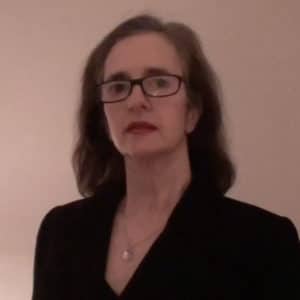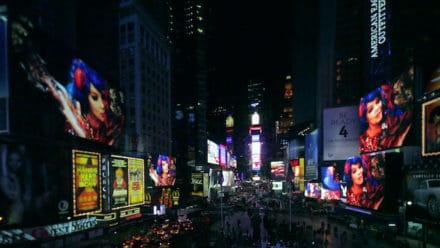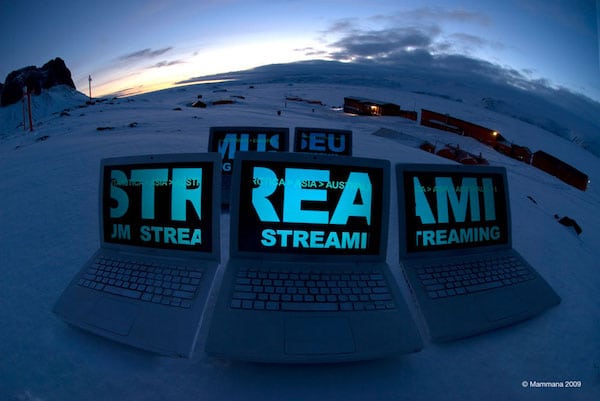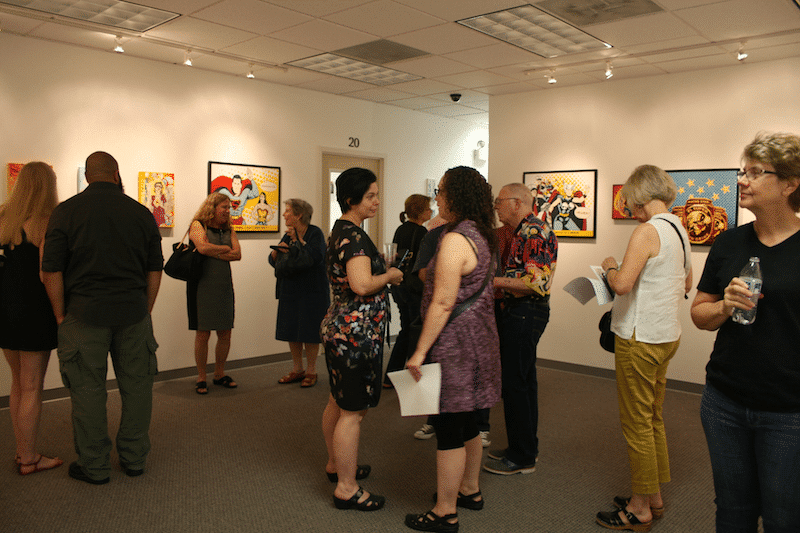Nina Colosi is the founder and creative director of Streaming Museum, which she launched in 2008 as a public art experiment, designed to produce exhibitions of art and present them in public spaces all over the world—at partnering cultural and commercial centers, as well as on the Internet. Since then, Streaming Museum has reached millions of people on all seven continents, in collaboration with more than 160 artists and 130 partners. Exhibition themes have evolved into programs that, within an art setting, bring together professionals in the arts, international affairs, the sciences, technology, education, and other fields.
In this Q&A with CHF Editorial Director Sofia Perez, Nina discusses ways that art can harness technology to disseminate visionary ideas and spur creativity; the value of interdisciplinary collaboration; and art as a practical tool for problem-solving.
Streaming Museum stretches the traditional concept of a museum. What was your goal in establishing it?
I was driven by a globalist/futurist impulse to use the expansion of mobile, Internet, and screen culture that was developing in the early 2000s. I wanted to make a symbolic gesture with art about the interconnectedness of society that technology was uncovering. Astronauts say that they grasp the reality of this oneness when they have the awesome transformative experience of seeing the Earth from space, which is called “the overview effect.” The exhibitions reflect the value of all cultures, that art crosses national borders that governments cannot, and that simultaneously “streaming” side by side are both the infinitely diverse ways that individuals see the world, and the commonalities we share around the basic needs of life.
If a museum is to follow the original meaning of its root word “muse” as the Greeks understood it (a being of inspiration and wisdom), and translate that concept into the contemporary world, a museum’s reach—its ability to transmit art’s macro and micro vision of the world—can be expanded through technologies that circulate to great numbers of people.

How did you start it?
The idea for Streaming Museum—the “a-ha” moment—happened in 2004, while I was director curator of The Project Room for New Media and Performing Arts at the Chelsea Art Museum in New York, working with artist, curator, and Professor Zhang Ga on his People’s Portrait, the first global Internet participatory public artwork. People in several international cities would step into a kiosk and snap their picture, which was then projected on a giant screen nearby where it alternated with portraits of people in other participating cities. It occurred to me that the idea could be developed into an ongoing circulation of art through a network of international screens. It took four years to make that happen.
After much planning at my computer and in collaboration with colleagues around the world, Streaming Museum’s first exhibition took place on January 29, 2008. At precisely the same time, at one location on each of the seven continents, we presented the video version of Nam June Paik’s Good Morning, Mr. Orwell (1984), a cross-cultural mix of fine art and pop culture.
Your museum is not linked to a single fixed physical space. How does that affect the kind of work you choose and how you display it?
Exhibitions take place in three realms, in collaboration with partners who own or direct public space properties, in cultural and commercial spaces, and on StreamingMuseum.org. Art is curated according to themes, so it can be any medium, and is selected according to the parameters of the location.
Because Streaming Museum does not have a public physical space (only a private studio in New York) and is “in residence” at each of the partnering venues, it can be considered part of the “sharing economy,” like Airbnb and Uber. I also look at the museum itself as a long-running global participatory public artwork.
What are some of the logistical challenges you’ve faced in mounting and staging specific exhibitions?
The process for exhibiting video-based art involves sending files to the locations through the Internet and having partners upload them to their systems. In the early years, some locations had spotty Internet capability, or the files were often too large, so I was mailing the work on CDs.
The best situation is to have screens that are connected internationally to reach the largest possible audience. The 23 interconnected BBC Big Screens that were linked across the UK were costly, and they were discontinued after the London Olympics. The good news is that UrbanScreens Productions, a partner of Streaming Museum since 2008, is in the process of building an interconnected international network.
Your museum is interdisciplinary, linking art with science, technology, and international affairs. Why was that blend vital to your idea, and did you encounter resistance to it?
It was important to me because I’m curious about how the world ticks together; how art interprets transhistorical connections that span from the distant past to the future; and how we can even begin to comprehend the reality that, as Carl Sagan said, “We are the stuff of stars.” It’s possible that a shift in understanding of what this means will happen as a result of the development of the space-exploration companies of billionaires Jeff Bezos, Elon Musk, and Richard Branson. Space tourism will give people the awesome mind-bending experiences that neuroscientists tell us influence our thinking.
“…Artists can create their own [public art] opportunities. They can organize solo or group shows by finding property owners, events, production companies, and organizations to approach…”
A View From the Cloud is an interdisciplinary project that we began in 2015, inspired by astronauts’ awesome transforming experiences of seeing the Earth from space. Co-produced with World Council of Peoples for the United Nations, it examines how art and technology sharpen the ways that we see the world and create solutions to the problems of humanity, in keeping with the UN’s Sustainable Development Goals (UNSDG).
The program has presented art exhibitions and conversations with astronauts, neuroscientists, artists, AI, global economic experts, educators, UN leadership, and the UN Department of Virtual Reality, Immersive Content, and the UNSDG Action Campaign (which has showcased projects of young hackathon winners who are developing solutions to world problems). Participants such as astronaut Nicole Stott, UN Assistant Secretary-General on Climate Change Janos Pasztor, Yale University’s Climate Change Communications Director Anthony Leiserowitz, and others also spoke about how artists can help communicate to the public complex ideas behind their work.
A View From The Cloud has been presented in New York at Dag Hammarskjold Plaza—which is considered the gateway to the UN—and the Church Center for the United Nations, as well as in Helsinki and Kvinesdal, Norway.
What can artists learn from collaborating with experts from other disciplines?
In interviewing artists about their creative process, I’ve found that their explanations are similar. Although they describe the specifics in different ways, they say that their art flows automatically from a subconscious realm and that the source of ideas seems to be a remix of their experiences of the world around them. Exploring other disciplines enriches the input of reality into an artist’s subconscious. The result of this exposure brings to their work a human comprehension and an emotional bridge to a fuller range of diverse information.
What advice do you have for artists who want to get involved in public art projects? How can they get involved with your museum?

Artists can research calls for art by local cultural or city planning boards, corporations, and arts festivals around the world. There are guides that list competitions for commissioned public artworks in various mediums. But artists can also create their own opportunities. They can organize solo or group shows by finding property owners, events, production companies, and organizations to approach about partnerships that might be interesting to them. Streaming Museum is open to reviewing work that could be considered for a range of programs, especially when it is recommended by colleagues.
Urban screen culture is in a new wave of expansion. For example, the Melbourne-based UrbanScreen Productions is developing a long awaited network of internationally connected urban screens, and the company Niio has created a system for managing and distributing artwork through a blockchain format. Obscura Digital, 3-Legged Dog, and many others companies and festivals around the world create awesome spectacles in public spaces.
Driving the field forward are university programs around the world taught by experts in the various aspects of media and art in the public realm. New organizations we are associated with that educate and initiate public programming are gaining momentum, such as the Media Architecture Institute in Ontario; and the international Urban Media Art Academy, co-founded by Susa Popp, who is also the co-founder of Public Art Lab in Berlin, and by Dr. Tanya Toft Ag, a scholar and educator who started her career in this field with Streaming Museum and has authored two books on the subject.
Tell us about how some of the museum’s projects have promoted the culture, international relations, historic commemoration, and tourism of countries; and given visibility to foundations and brands that support the arts.
In terms of the activation of both commerce and the cross-cultural connections, I had first seen proof of concept in the 2004 People’s Portrait project, which inspired the creation of Streaming Museum. New York’s Times Square was one of the sites for public participation, and the project brought visibility to the Times Square Advertising Coalition, which spurred their interest in developing what has become an ongoing world-renowned arts program. Over the years, Streaming Museum has been involved in several Times Square Arts “Midnight Moment” programs, which present the work of one artist nightly for a month across the screens in this cultural crossroads of the city, one of the most visited locations in the world.

Streaming Museum has brought together culture and commerce in several of our projects, among them Contemporary Crosscurrents: Portraits and Electronic Arts, sponsored by the Dubai-based international real-estate company Emaar Properties. It was the first exhibition in public space in the United Arab Emirates, and it brought together artists from the Middle East with international artists. Another project was Cross-Korea: Come Join Us Mr. Orwell, an internationally touring exhibition that showcased Korean arts and culture, along with some of the country’s leading cultural organizations, including Art Center Nabi, Korean Film Archive, and the Nam June Paik Art Center.
Nordic Outbreak was a year-long global tour of the work of 30 Nordic video artists, co-produced with Dr. Tanya Toft Ag, who I mentioned earlier. Sponsored by the consulates of all the Scandinavian countries and some of their leading foundations, it launched in Times Square with a special version of Bjork’s Mutual Core film. Now, after five years, Tanya has developed the project further to include a book, Digital Dynamics in Nordic Contemporary Art, and a global tour (entitled Arts New Natures) is also planned..
Another program we produced was an historic commemoration of the 20th anniversary of the fall of the Berlin Wall, featuring an exhibition by artist Edwina Sandys, granddaughter of Winston Churchill. In Milan, it was the official program that was projected onto the city’s Piazza Duomo, the largest screen in Europe, and was introduced with a military parade. It was also presented in Berlin itself, at the largest metro station, for the celebration of the 25th anniversary.
Obviously, public art is beneficial to cities because it is a tourist attraction that brings revenue to local businesses and increases real-estate values, but wherever it is showcased, it also brings beauty, ideas, and excitement, all of which enhances the quality of life of neighborhoods of all sizes.
What’s the most rewarding part of your work with the Streaming Museum?
It’s been very rewarding to see that A View From The Cloud has brought together experts in different fields who normally would not interact. They found common points of discussion that continued after the program was over, and recognized that art could connect people to the complexities of their work in ways that go beyond their factual reports.

I’ve realized that art has practical problem-solving capabilities that are underutilized, but this can be said about human capabilities as well. A point of inspiration has been learning about neuroscience studies that look at bias and methods for transcending conflict, and how awesome experiences can open people to new ways of thinking.
A great influence has been my friendship with Allegra Fuller, the daughter of the late Buckminster Fuller, the architect, systems theorist, author, designer, inventor, and futurist. Bucky called himself a “trimtab,” referring to the small rudder that moves large ships. He said that one person has the power to change the world, which his work continues to do through the Buckminster Fuller Institute.
I hope that Streaming Museum’s circulation of art and ideas has planted some seeds of creative ideas and understanding about society’s interconnection, even if only to a small number of people whose actions will reach into the future. Creativity breeds more creativity.
Now that you’ve just celebrated your 10th anniversary, what’s ahead for the Streaming Museum?
Among the goals now is to create new artwork around the concepts explored in A View From The Cloud. Plans are in progress for a collaboration with the Constellation program founded by astronauts Nicole Stott, Ron Garan, Anousheh Ansari, and Leland Melvin. It launched with an exciting event at the Kennedy Space Center on December 21, 2018, announcing its educational mission to help people around the world better comprehend the interdependence of life on Earth.
In order to raise The Foundations we need to continue exploring these ideas and developing new projects, Streaming Museum now offers collectors the work of artists who’ve been featured in our programs, as well as other works, through partnering international art advisors. This move was inspired by artists Christo and Jeanne-Claude, who have sold their own art to fund their large-scale pieces, and art collector and president emerita of the Museum of Modern Art, Agnes Gund, who sold a $150M Lichtenstein in her collection to start the Art For Justice Fund, which aims to turn art in action, with the goal of reforming the criminal justice system.
We always welcome conversation and collaboration.






